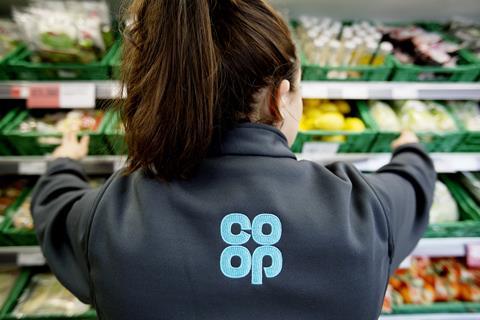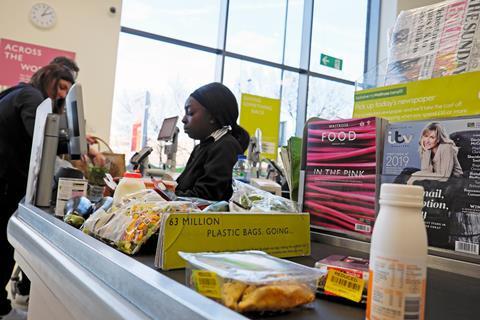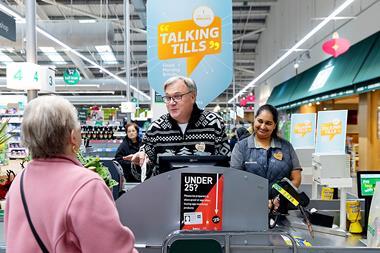Chasms remain in pay gap reporting – but not for long. Moves are afoot to introduce mandatory reporting on ethnicity and disability pay gaps, on top of the gender requirement. How should companies prepare for the changes, and will socioeconomic background be next on the list?
What gets measured gets done. It’s a phrase The Grocer hears time and time again when investigating pay gaps. Considering very few fmcg companies go beyond the legal minimum – gender pay gap reporting – further measuring would certainly be a start.
And soon, there won’t be much choice. On 18 March, the UK government launched a consultation on mandatory reporting for ethnicity and disability pay gaps, too. That closes on 10 June, and the draft Equality (Race and Disability) Bill is widely expected to be made law. What’s more, there are calls for socioeconomic background (SEB) to be added to the mix.
So where does the sector stand on pay gaps? Who’s reporting on what? What are the difficulties around extending mandatory reporting beyond gender? And what outcomes might that produce?
The legal requirement for gender reporting – introduced in 2017 – means all companies are aligned on that front. That doesn’t mean all is rosy. A study of more than 10,000 companies by employee benefits consultancy Isio earlier this year found it will take another 40 years to close the UK’s gender pay gap at the current rate of improvement.
However, the mandatory collection and disclosure of data means companies can at least measure what’s going well – and what’s not going so well.
Lately, some big retailers have had to admit a backwards step. Tesco, which says it was one of the first UK companies to voluntarily report on pay by gender, was one of the supermarkets to disclose a widening of its median and mean pay gaps. Ocado Retail and the John Lewis Partnership also recorded increases on both measures.
Elsewhere, it was a more mixed picture. Asda’s mean gap rose by 0.4% but – even with that increase – it has the smallest discrepancy of the 11 major supermarkets, at 7%. It has the second-smallest median pay gap, too – a measure that’s not so impacted by the very highest and lowest earners. On that front, it’s behind only Lidl, which has had a median pay gap of zero for the past four years.
There were some improvements in the sector, too. Aldi cut its mean pay gap from 9.1% to 7.4%, while Morrisons’ fell from 12.5% to 9.9%, despite a marginal increase in its median gap. Co-op also pushed down its mean pay gap from 13.2% to 10.8%.
While pleased with the progress, Co-op’s social mobility manager Lorna Jones points out “in the past few years, our gender pay gap has gone a little bit up and down”. A certain amount of fluctuation is relatively normal “depending on who you’ve got in the organisation”, she adds.
Currently, M&S has the largest mean gender pay gap at 12.2%, though a spokesperson tells The Grocer its making “strong progress”.
“Women now make up 50% of our senior leadership team and 55% of our board. In our stores, women are also 52% of our store management population.”
The gender pay gap picture is somewhat different at heavyweight suppliers such as Arla and Suntory. Arla’s 2024 Gender Pay Gap Report shows women are paid more than men – with negative gender pay gaps of –47.3% on a mean basis and –4.3% on median.
Fran Ball, VP of UK production at Arla Foods, points out this is because “the majority of women employed across Arla UK hold manager and director roles”. The company is now aiming to increase the number of women in the overall UK workforce, with a target to increase female applicants from 15% to 27% by 2030 .
It’s a similar story at Suntory, where the gender pay gaps are –10.2% mean and –21% median. “While our report, showing a gap in favour of women, is in part a factor of our industry, we continue to work hard encourage more women into manufacturing,” says Elise Seibold, chief operating officer at Suntory Beverage & Food GB&I.
“Through learning and development opportunities, considered recruitment and clear succession planning, we also have females in senior roles not typically considered ‘female’.”
Seibold is keen to see gender pay gap reporting extended to other minority groups. “Yearly reporting would be a positive step to help us all drive progress,” she says.
The missing pieces of the puzzle
As she points out, the gender pay gap is out in the open – and that information can be used to take action. On other characteristics, though, fmcg is lagging behind sectors such as professional services and law firms.
Of the 11 major supermarkets, only four are reporting on more than the legally required minimum of gender. Sainsbury’s has been reporting on its ethnicity pay gap for four years now, while Tesco began doing so for the first time last year and JLP started in 2019.
Instead, most are in preparation mode for the upcoming requirements on ethnicity and disability. Multiple retailers and suppliers – including Sainsbury’s, Waitrose, Morrisons and Arla – tell The Grocer they are exploring ways to encourage employees to voluntarily self-report on a wider range of diversity characteristics.
Co-op is the only supermarket that already reports on gender, ethnicity and disability, plus one characteristic that isn’t facing a legal requirement: SEB.

“We’ve been doing gender and ethnicity for a number of years, and last year, we brought SEB into the mix. The reason for doing that is we treat socioeconomic background with the same importance as we do the protected characteristics,” says Jones. “When we looked at SEB reporting, there was no one in the fmcg space doing it, so we thought: Let’s lead the way.”
The methodology is “not as scary as it might seem initially”, Jones reports. “Organisations have to do their gender pay gap reporting anyway, so essentially, once you’ve got that methodology down, you can apply it to any characteristic.”
The simplicity is reiterated by Rosalind Goates, head of advocacy and campaigns at the Social Mobility Foundation. “It’s a case of adding a question on the occupation of the main household earner at age 14 to existing diversity surveys,” she points out.
For her, “class remains the missing piece of the diversity, equity and inclusion puzzle”. As it’s not a protected characteristic, it’s not a legal reporting requirement.
“That’s why we’re campaigning for mandatory SEB reporting for all large employers, because we know what gets measured gets done – and you can’t fix what you don’t measure,” Goates adds.
Mean and median pay gaps explained
The mean pay gap is the difference in the average hourly pay of all women compared with all men in a company. The mean is calculated by adding together all the women’s (or men’s) salaries and then dividing it by the number of women (or men) in the company.
The median represents the middle point of a given population. If all the women from one business were lined up, and all the men from the business were also lined up, the median pay gap would be the difference between the hourly pay rate for the middle woman compared with that of the middle man.
The bigger issue is data collection. Co-op has worked hard on SEB data, where it has an 81% completion rate. “If you’d asked me three years ago, I wouldn’t have thought we’d get to that figure, because people aren’t used to being asked questions that define socioeconomic background,” Jones says.
“It’s something that’s still a bit uncomfortable and a bit taboo in British society. You do get people saying: ‘Why do you need to know what my dad did when I was 14?’ – which is the key question out of four recommended by the Social Mobility Commission.”
There are also difficulties collecting data on disability, which is soon set to become a legal requirement. Co-op has already hit 91% completion – mainly, Jones thinks, because “people are more used to being asked” for that information – but it’s not so easy for everyone.
“One of the biggest challenges in getting good data on disability is building a culture of trust, so employees feel safe to share information on disability and long-term health conditions,” says Fazilet Hadi, head of policy at Disability UK. She believes “it would be good to implement monitoring in advance of legislation”.
That point is hammered home by Tea Colaianni, founder and chair of Diversity in Retail. While gender reporting has become embedded in companies, extending that to “other aspects of identity such as ethnicity, disability or SEB is discretionary and far more nuanced”, she says.
There is also a “lack of a clear and consistent framework to guide what should be collected and why” and “a fear of reputational risk”, Colaianni adds.
“Companies may hesitate to collect or publish data that could reveal wider pay gaps in ethnicity or disability than in gender, especially if they’re still early in their journey.”
“Data collection can also be sensitive and emotive, so it’s essential organisations understand and clearly communicate the why, the what and the how of their approach,” she adds. After all, among the companies working with Diversity in Retail, “disclosure rates vary widely from below 30% to nearly 90%”.

Employee trust
For the experts, the key to gathering the data is trust. This involves frequently reiterating why the data is being collected and then, when companies take action, communicating the positive changes.
“It’s about constantly linking it back,” says Co-op’s Jones. “There are parts of our organisation where people are still a bit more reluctant to share that information, so we’ve done targeted activity with them. It’s that constant drum beat of: Please give us your data, this is what we’re using it for, this is why we’re asking.”
That drum beat should be coming from senior leadership, says Colaianni. “This message must come from the very top and be communicated consistently and regularly – it cannot be treated as a one-off initiative.”
What happens after the data is collected is just as important. “Organisations must invest in analysing it thoughtfully and use the insights to inform meaningful actions that drive real progress,” Colaianni says.
“Crucially, organisations should also involve employees in shaping solutions. Surveys and focus groups can reveal how disparities play out in practice.”
Co-op can vouch for the positive actions to come from reporting. For example, its wealth of quantitative and qualitative data helped to identify women from a lower SEB as experiencing the biggest pay gap in the company. It responded with a development programme for that specific group to offer the tools, the confidence, or whatever is needed to overcome those barriers.
Furthermore, reporting on SEB background and targeting social mobility has “brought colleagues who have historically felt like DEI is ‘not for them’ into the mix a little bit” says Jones.
Given those clear positive outcomes – or the “carrot” – Co-op is firmly on the side of reporting. Jones can understand nervousness over the upcoming “stick” of mandatory measures on ethnicity and disability. “You can’t get away from the fact that when things are made mandatory, it obviously shines a light,” she concedes.
Nevertheless, she believes the law will be a game-changer in all the right ways: “That’s when we’ll see more action.”
GroceryAid on gathering data
Organisations can take several steps to start gathering data on pay gaps. Here are GroceryAid’s tips on getting the numbers and analysing them through an intersectional lens, which can reveal challenges that might remain hidden when examining each set in isolation.
Be really clear on the data you are looking to collect, why you are collecting it and what you are planning to do with it. Just start simple.
Evaluate existing systems to ensure they support effective user experiences, data collection methods, secure data storage and appropriate privacy protections.
Have a look at existing processes to see how you can integrate data collection into familiar activities to make it easy and simple, and enhance participation rates and employee comfort.
Foster an environment in which employees feel safe sharing information and feedback. That will allow you to capture more accurate data.
Develop a comprehensive communications plan that also provides support such as FAQs, definitions and interactive awareness activity.
It’s important to learn how to analyse your data to understand where any potential biases lie and also to set measurable targets.
Consistent reporting schedules will allow you to track progress against established targets and demonstrate commitment to ongoing improvements.
On GroceryAid’s Partner HUB we have a range of resources available to our partners, including Learning Lab videos to watch on-demand which will help with the above, covering everything from reporting guidance to advice on questions that can be asked.




















No comments yet